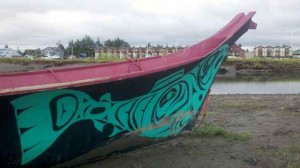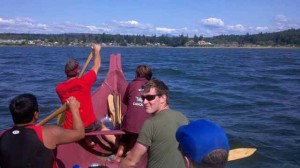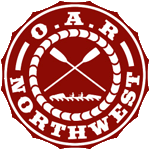My brother Doug and I rolled through Skagit Valley toward La Conner at dawn. Six hours ago Dr. Eric Grossman, AKA Dr. Surf of the USGS, had invited Doug, Greg and myself last minute to Canoe Journeys. This is an annual Native American event that has happen annually in the Salish Sea since 1989. A destination is picked and the tribes from farthest out begin the several week journey towards a final gathering. Women, men, young and old—everyone participates.
For the last several years Dr. Surf and his wife Sarah, who works for the Swinomish Tribe, has collaborated with the Journeys for research. They attach a device to the back of the canoe and collect water quality samples during these several hundred-mile trips. He and his colleague, Peter Horne are responsible for the near real time live data map on our website. Here is the link. (Please be patient while it loads.) You can see what he has been doing with the Canoe Journeys for the last few years at this link.
The lone ochre colored canoe with a teal Salish image of a salmon sat alone on the mudflats across from La Conner. The words next to the image roughly translated to “spirit of the salmon.” We waited for the skipper, also named Eric.
He had not yet been able to scare up any bodies the night before and was not optimistic that five people paddling the canoe could make a doubly long day to Tulalip 35 miles south. Sarah explained that the canoe calls people to paddle it. Now it looked like it had not called enough. Eric sighed got on his phone. In the time it took to get a cup of coffee the canoe, through Eric, had managed to pull three more out of bed and we were joined by Bugsy, Mattie, and Adam.
 Eight of us, still stiff with sleep—or lack of it—gathered in a circle. Eric led a quick prayer. We heaved the canoe through the slick mud into the slough. In the middle of the channel Eric ordered our paddles up and out of the water. In a soft voice that carried he ordered us to note of the eye carved into the handle just above the blade.
Eight of us, still stiff with sleep—or lack of it—gathered in a circle. Eric led a quick prayer. We heaved the canoe through the slick mud into the slough. In the middle of the channel Eric ordered our paddles up and out of the water. In a soft voice that carried he ordered us to note of the eye carved into the handle just above the blade.
“It must always face our destination,” he said.
Unlike the dugouts of the past, Eric’s vessel, the first of his tribes canoes in many years, was a composite of marine plywood, cedar and veil fiberglass. It’s beam roughly three and a half feet with a length of about thirty. With seven paddlers we cut through waves, wake and headwinds at an easy five knots.
Clouds gave way to the haze softened sun characteristic of the Salish Sea this time of year. Adam began to sing in a deep rich voice a song both exotic and familiar. Our canoe danced with each stroke. When Adam stopped, Bugsy picked up, and then Eric—sometimes they sang together.
“Paddles up,” ordered Eric. Above an eagle swooped high across the bow. He was hunting. We watched in silence until he landed in the trees.
Hours drifted under steady labor. Twice we broke for snacks, lashing the canoe to the support boat driven by Eric’s brother Ron. A young man named Thomas was in the support boat. He decided to join us. This was his ninth canoe journey. He was Eric’s son. Tulalip was his tribe as well. Today he paddled from home to home.
We approached shore but could not just land. Each canoe, by now over three dozen, paddled in a circle past a crowd of nearly a thousand and lined up next to one another. At least three hundred of the angular Salish paddles pointed in the air like a forest of oddly shaped trees. Protocol began. The host on shore exchanged greetings and prayers of peace and thanksgiving with the skipper.
Twenty-two years ago nine canoes paddled to Seattle for the first time in more than a generation. When this journey finished in Squaxin Island a week later it would be with well over one hundred. As Protocol moved down the line each canoe peeled off and headed down the beach to the landing point. Eager hands waited on shore to help us with our canoe and we carried her up the beach and onto the grass.
We cleaned it. I looked down to see the canoes that were starting to come out of the water were carved of huge single logs—much heavier than our composite craft. Thirty or more people would wade into the water and pick it up and over their heads and move millipede like up the beach.
The last of the canoes were the Alaskans. They had traveled furthest and brought the heaviest vessels of ancient cedar. Unlike the composite each of these curved slightly asymmetrical with the grain of the wood. Their chief, a large man, would come out the water with his tribe’s canoe. At first he refused but shouts rang out in protest and he sat down. I lined up to help with Doug and Greg. Cries for more hands rang up to the beach and soon the slippery hull was invisible beneath the palms. In two powerful moves the slick and textured craft lifted from the water and to our shoulders.
 Twice more we went down to the beach. Each canoe seemed heavier than the last. The wooden hulls were filled with hundreds of pounds of gravel ballast, day’s supplies, and honored members of their community. We pulled the last canoe to our waist. Sounds of human straining filled the air. With a concerted heave it moved unsteadily to our shoulders. Shuffling out of the water with bare feet we stumbled on the shells and rocks. Halfway up the beach it began to tip precariously. I feared the worst. A cry rang out from the back.
Twice more we went down to the beach. Each canoe seemed heavier than the last. The wooden hulls were filled with hundreds of pounds of gravel ballast, day’s supplies, and honored members of their community. We pulled the last canoe to our waist. Sounds of human straining filled the air. With a concerted heave it moved unsteadily to our shoulders. Shuffling out of the water with bare feet we stumbled on the shells and rocks. Halfway up the beach it began to tip precariously. I feared the worst. A cry rang out from the back.
“Hoo!” A man yelled from the stern.
“Haa!” Half the crew replied. Two thousand pounds of wood, rock and two elders steadied.
“HOO!” He bellowed .
“HAA!” We cried.
The canoe moved up the beach.
